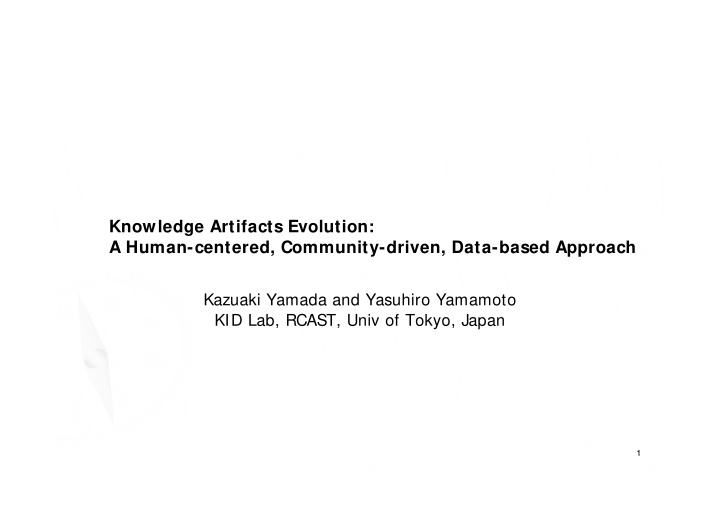



Knowledge Artifacts Evolution: A Human-centered, Community-driven, Data-based Approach Kazuaki Yamada and Yasuhiro Yamamoto KID Lab, RCAST, Univ of Tokyo, Japan 1 1
knowledge artifacts designed and created by human being ► not only: software, software components, software systems ► but also: learning, experience, retrieved information 2
example domain: online e-learning ► e-learning and online communities ► different learners have different goals ► learners' knowledge evolution ► collaboration among learners ► collaboration between learners and content providers ► collaboration among content providers 3
tools to facilitate knowledge artifacts evolution ► human-centered: human interactions with support tools ► community-driven: knowledge communication among members ► data-based: information clustering and multi agents 4
Existing Approaches for Analyzing Community Activities ■ (1) “narrow” approaches: Community observe a tiny part of community activities and generalize the findings. generalization ■ (2) “shallow” approaches: generate a simple mathematical model and simplification ∂ simulate community activities x = + + + 2 x ax by c based on the model. ∂ y Both approaches need a pre-understanding of what to look for as a problem. They are not adequate for uncovering emerging problems. 5
Understanding Community Activities ■ In order to - discover problems occurring in the community - design new methods to support the community ■ We need to understand detailed activities of people in the community by analyzing -knowledge artifacts that people create -knowledge artifacts that people use -the process of how people create knowledge artifacts -the process of how people use knowledge artifacts -interactions among the community members 6
UmCmModel 7
Multi-agent Simulation Agent with a decision- making system which is made from the UmCmModel ■ Multi-agent simulation environment ■ Through the multi-agent simulation, We can expect as follows; - Simulate what users are doing in the real world - Predict the users’ behavior and the interactions among the users in the near future 8
Recommend
More recommend